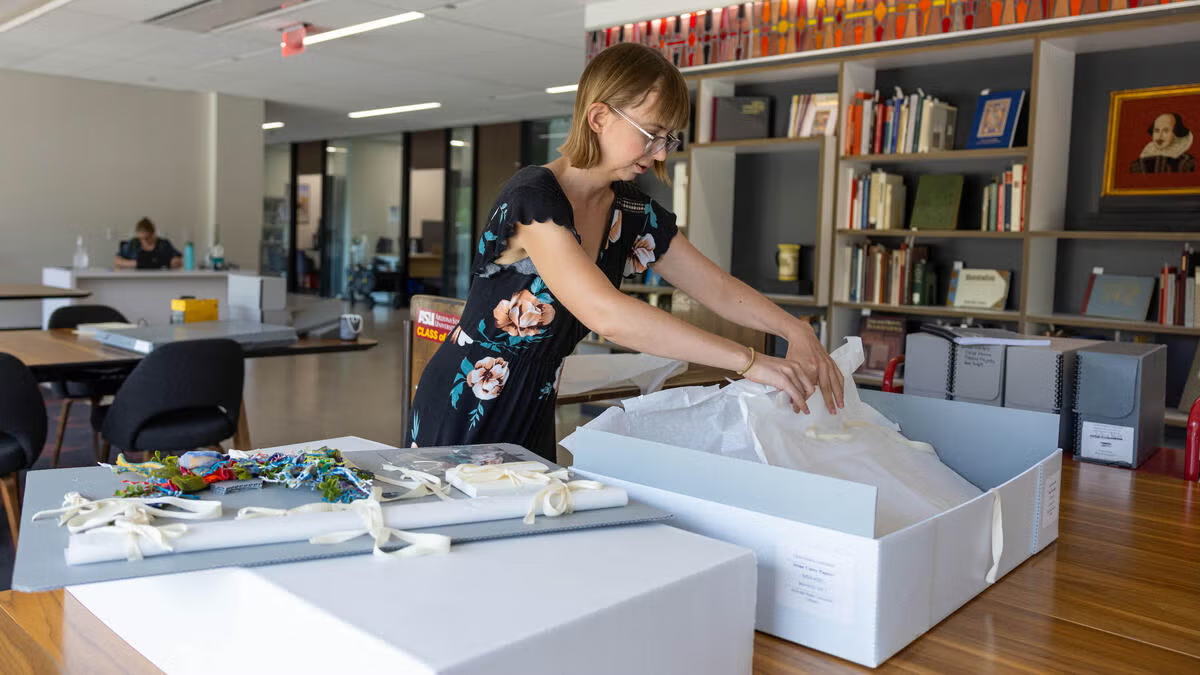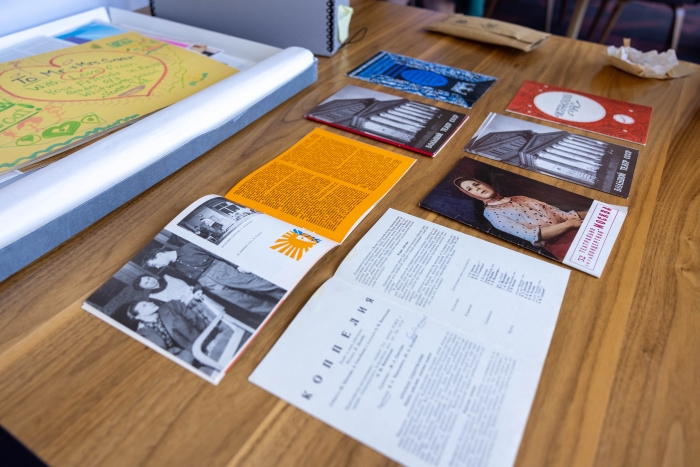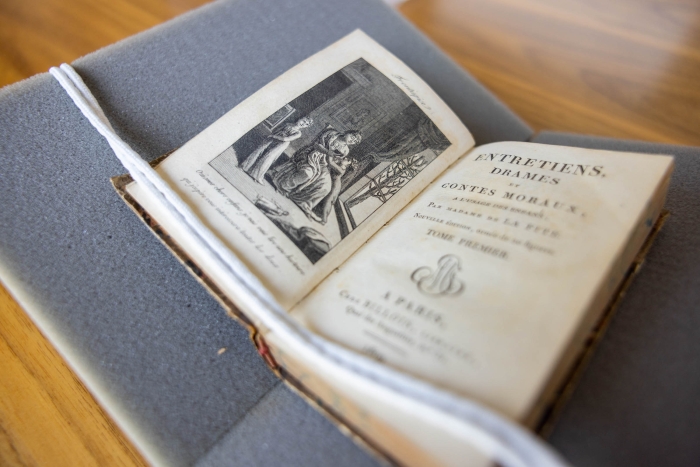ASU’s Theatre for Youth and Community Collection still in spotlight after all these years

ASU Performing Arts Librarian Caelin Ross unboxes part of the Theatre for Youth and Community Collection, including costume pieces by Irene Corey for “The Tempest,” in the Wurzburger Reading Room at Hayden Library in Tempe. The collection dates back to the 16th century and contains international items pertaining to the history of theater for youth and theater education. Photo by Samantha Chow/ASU
Editor’s note: This is the first of a monthly series spotlighting special collections from ASU Library’s archives throughout 2024.
This story is featured in the 2024 year in review.
As far as performing arts collections go, Arizona State University has been a star attraction for more than four decades.
Its Theatre for Youth and Community Collection is the largest, most utilized and internationally renowned youth-theater repository in the world, according to university officials.
With items dating back to the 17th century, the collection attracts scholars, playwrights, teaching artists, performers and students from far and wide to study its costumes, scripts, rare books, designs and ephemera, allowing youth and educators to take center stage and empowering them to tell their own stories.
“We often forget about the importance of theater for youth because it’s really the start of their creative engagement with the outside world,” said ASU Performing Arts Librarian Caelin Ross. “This collection is about sustaining them in a craft that is important and helping them build community, (centering) them in their own decision-making and artistic practice. The collection is important, but the engagement and the impact it can have on their lives can be invaluable.”
Ross took on curatorial responsibilities in 2023 when she relocated to Tempe from Chicago to begin the position. She continues the work of curator Katherine Krzys, who retired in 2019.
“This job is nothing I ever imagined or could have envisioned for myself,” said Ross, who is a former youth performer. “In the beginning, I did not fully understand the significance of the collection to the university or the field, but now I do. Today, I am humbled and grateful to be in this role.”
Formerly known as the Child Drama Collection, the archive has welcomed visitors to ASU since 1979 — that’s when it was established by librarian Marilyn Wurzburger, head of Special Collections, and by Lin Wright, then chair of the ASU Department of Theatre. They recommended developing a repository in response to the academic needs of youth-theater students and faculty at ASU and the research needs of professional artists and educators worldwide.
“We started the collection because a number of leaders in the field of child drama were retiring at the time and their materials were valuable to the teachers and directors,” said Wright, who has been retired from ASU for nearly a quarter-century and had her papers dedicated to the collection. “I was very active nationally at that time and thus was able to be helpful. I did see that the collection started to grow and tried to see that those in the field knew of its existence.”
Many who come to study the collection are astounded by its content and breadth, which measures approximately 3,000 linear feet. That’s about the length of eight football fields or a dozen 747 jumbo jets lined up back to back.
While it is securely housed in offsite remote storage, the collection is part of the ASU Library system and can be requested to view by appointment. Ross has plans to engage even more closely with students and community members.
“There’s this perception that archivists and librarians just want to collect things and keep them away from the public, but that’s not the case at all,” Ross said. “My job is to think about how we can foster stronger partnerships at the university and in our community to make them aware of the resources we can provide. We also want to let them know what we have, how we can help, and that we genuinely care about collaboration.”
To that end, Hayden Library on ASU’s Tempe campus will host an open house in the Wurzburger Reading Room from noon to 1 p.m. on Wednesday, Jan. 24. Visitors will have a chance to meet Ross and view a display of the items, including educational materials and manuscripts related to the history of youth theater. For more information, visit the ASU Events website.
David Saar, an ASU graduate and past contributor to the collection, said he plans to attend.
“The collection is the most complete historical record of the development of youth theater, which has come a very long way in 50-some years,” said Saar, the founding artistic director of Childsplay Theatre, a Tempe-based acting troupe that ASU frequently collaborates with. “It is so professionally preserved and well-documented.”
That’s why he decided to donate the David, Sonja, and Benjamin Saar Yellow Boat Collection to ASU in 2000. It contains framed drawings, posters, correspondence from audience members, letters and drawings from schoolchildren, photographs, press releases and other materials documenting the writing and production of “The Yellow Boat,” a play Saar wrote for his son Benjamin, a hemophiliac who contracted AIDS through a blood transfusion and died from related complications in 1987 at the age of 8.
Saar also gifted the Childsplay records to ASU. It includes 181 boxes of videotapes and DVDs from past productions, scripts, posters, workshop and planning materials, and set models. His successor, Dwayne Hartford, said he makes trips to Hayden Library when the need arises.
“I go there when I’m researching our history or when we are looking for a song in a show that was never published or maybe a lobby card we used in previous play,” said Hartford, who has been Childsplay’s artistic director since 2016, “or perhaps when there’s an anniversary or some kind of special event where we need to draw on something from the past.”
In addition to those two collections, the archive is filled with other treasures. They include such gems such as a 17th-century bound book of plays by Greek tragedian Aeschylus, a stained glass-inspired costume from the “Book of Job,” and a scrapbook of photos from the Children’s Theatre of Evanston, which shows the first national meeting of child-drama pioneers at Northwestern University in 1944. It also includes founding records from the first international association focused on theater for youth, ASSITEJ International, discovered during the Cold War in 1965.
Other highlights of the Theatre for Youth and Community include:
• Irene Corey Collection: For over a half-century Corey designed costumes, sets and makeup for theater classics, theme-park characters and television shows, most notably “Barney and Friends.” She first became nationally known for the “Book of Job” in the 1950s, which had a 22-year run throughout the world. This collection, donated in 1995, includes historical costumes, animal makeup renderings, production photographs, and her historical and cultural research files.
• Jonathan Levy Collection: Donated in 1999, it contains more than 350 books with copyrights from the 17th through 20th centuries and manuscripts chronicling Levy's academic and professional career. Before getting this archive, the Theatre for Youth and Community Collection documented the field's history only from 1900 onward. The Levy collection expanded research possibilities back to the 16th century.
• Lowell and Nancy Swortzell Theatre Arts Collection: The award-winning Swortzells, who created the Educational Theatre Program at New York University, saved every scrap of paper — every letter, photo and class note — from their careers and started donating them to the collection so that their scholarship and teaching methods could be shared by scholars. This was the largest single donation of books and manuscripts to the Theatre for Youth and Community Collection.
The collection is not an archive of the past — it is active and forward-looking. And it’s constantly being accessed by the youth-theater community, scholars and higher education students like Ali Brady.
Brady, a second-year MFA candidate in the Theatre for Youth and Community program, said the collection sparks the imagination.
“Working with the collection has allowed me to think more creatively about research methods and primary resources,” said Brady, a student worker who works directly with Ross. “There is no end to the amount that can be explored and created in this collection. As a person interested in community engagement in the arts, I am excited how the collection grows to incorporate more of that field as well as the interests that other scholars and theater enjoyers alike in our community may have.”
Mary McAvoy, an associate professor in ASU’s School of Music, Dance and Theatre, often turns to the collection for research on her books and other teaching materials.
“I use it all the time for research, but more importantly, it’s a teaching resource for our students,” said McAvoy, who is also the program director for the Theatre for Youth and Community undergraduate and graduate programs. “It’s a wonderful place for them to see what other playwrights and directors were thinking about, the memos they were sending to each other to discuss what they wanted to do and what they cared about at the time. That research can inform them in their decision-making and future development.”
And speaking of the future, Ross said upcoming collection plans include integrating collections into new theater courses focused on dramaturgy and devising. She also hopes to work with Rising Youth Theatre in Phoenix to host archival workshops with youth and provide oral history training. Future exhibitions with the collection will provide an immersive experience, integrating audio and video elements.
“I am especially interested in the potential for future collaborations with colleagues in the Community-Driven Archives Initiative to strengthen our connections with community,” Ross said. “There is so much possibility as the field continues to become rich in terms of genre — including eco theater, intergenerational work, queerness, social justice, theater for the very very young, and more. Diverse representation and inclusion are at the center of the future of this collection.
Monthly series spotlighting ASU Library’s special collections
- January: Expanded Theatre for Youth and Community Collection remains a repository for emerging artists and educators
- February: Black Collections aims to document the lives of an underrepresented Arizona community
- March: Voices from Latin America can be found in dynamic research collection
- April: Thunderbird archives: These walls do talk
- May: Collection preserves legacy of modern architects, buildings in the Southwest
- June: LGBTQ+ Studies Collection a repository rich in legacy
- July: Pop-up book collection is deceptively simple fun
- August: A (re)source of Sun Devil pride
- September: Chicano/a Research Collection filled with action, education and activism
- October: ASU collections offer Indigenous perspective through traditional storytelling, innovative methodology
- November: University Archives chronicles more than 140 years of Sun Devil history
- December: Collection captures the robust history of Arizona
“Theater should belong to everyone.”
More Arts, humanities and education

Local traffic boxes get a colorful makeover
A team of Arizona State University students recently helped transform bland, beige traffic boxes in Chandler into colorful works of public art. “It’s amazing,” said ASU student Sarai…

2 ASU professors, alumnus named 2025 Guggenheim Fellows
Two Arizona State University professors and a university alumnus have been named 2025 Guggenheim Fellows.Regents Professor Sir Jonathan Bate, English Professor of Practice Larissa Fasthorse and…

No argument: ASU-led project improves high school students' writing skills
Students in the freshman English class at Phoenix Trevor G. Browne High School often pop the question to teacher Rocio Rivas.No, not that one.This one:“How is this going to help me?”When Rivas…




